Service line:
+86-18258773126
E-mail:
Hot Keywords:
- All
- Product Name
- Product Keyword
- Product Model
- Product Summary
- Product Description
- Multi Field Search
Views: 18 Author: Site Editor Publish Time: 2025-09-25 Origin: Site











Have you encountered this frustrating and dangerous situation? A hydraulic hose assembly fails catastrophically, with the hose pulling cleanly out of the coupling, as shown in the image below. This is more than just an inconvenience; it's a clear sign of a critical failure in the hose assembly process that can lead to costly downtime and serious safety hazards.

This specific failure mode points directly to one core issue: an improper crimping process.
In simple terms, the metal sleeve (ferrule) was not crimped with enough force or precision to create a permanent, high-strength mechanical interlock with the hose's outer cover and internal wire braid. When system pressure or physical tension is applied, the hose simply slips out.
Based on the evidence in the picture—where the hose is extracted cleanly, exposing the undamaged wire braid—the primary cause is almost certainly insufficient compression during crimping.
Let's break down the most common reasons for this failure, from most to least likely:
This occurs during the crimping operation itself.
Insufficient Crimp Diameter: The crimping machine was set to compress the sleeve to a diameter that is too large. This results in inadequate "bite" into the hose, failing to grip the reinforcing braid securely.
Wrong Die Selection: Using incorrect crimping dies for the specific hose and coupling combination will guarantee an improper crimp.
Insufficient Hose Insertion: The hose was not pushed fully into the coupling until the tube bottomed out against the coupling shoulder. If the crimp is not applied over the coupling's serrated "grip zone," the connection will be weak.
Worn or Misaligned Dies: Worn-out crimping dies can create an uneven crimp, leaving weak spots. Misaligned dies apply pressure incorrectly, compromising the integrity of the connection.
Mismatched Components: Using a coupling or sleeve not specified for the specific hose type can lead to compatibility issues, as dimensions and tolerances vary.
Hard/Slippery Hose Cover: An unusually hard or smooth outer cover on the hose can reduce friction and contribute to pull-out, even with a seemingly correct crimp.
Prevention is always better than cure. To ensure reliable and safe hose assemblies, adhere to these best practices:
Follow Manufacturer Specifications: Always use the crimp diameter and tolerance specified by the coupling manufacturer. Measure the final crimp diameter with a caliper.
Verify Insertion Depth: Before crimping, always check that the hose is fully seated against the coupling shoulder. Look for the insertion mark on the coupling stem.
Maintain Your Equipment: Regularly service and calibrate your crimping machine. Inspect dies for wear and tear.
Use Matched Components: Source your hose, couplings, and ferrules as a matched set from reputable suppliers to ensure compatibility.
A hose assembly that has failed in this manner must be scrapped immediately. Do not attempt to re-crimp or reuse it. A failure under high pressure can release hydraulic fluid at extreme velocities, causing severe injection injuries, fire hazards, and equipment damage. Your safety is paramount.
Proactive maintenance, proper training, and using quality components are the non-negotiable pillars of a safe and efficient hydraulic system.
For professional technical support and high-quality hydraulic components, pls contact:
Cixi Zhouxiang Hand Hydraulic Co.,Ltd.
This article provides general technical guidance. Always consult the specific technical data sheets from your hose and coupling manufacturers for detailed instructions.
Hydraulic Fitting Face-Off: What the Nut Reveals About Quality
Hydraulic Hose Pull-Out Failure: A Classic Crimping Mistake (With Visual Evidence)
production is continuing, sharing some photos of hydraulic fittings
The Importance of Pressure Ratings and Testing for Hydraulic Fittings
It's the middle of 2019, expanding hydraulic fittings sales is our goal
After the Chinese new year, Production for Hydraulic fittings continues.